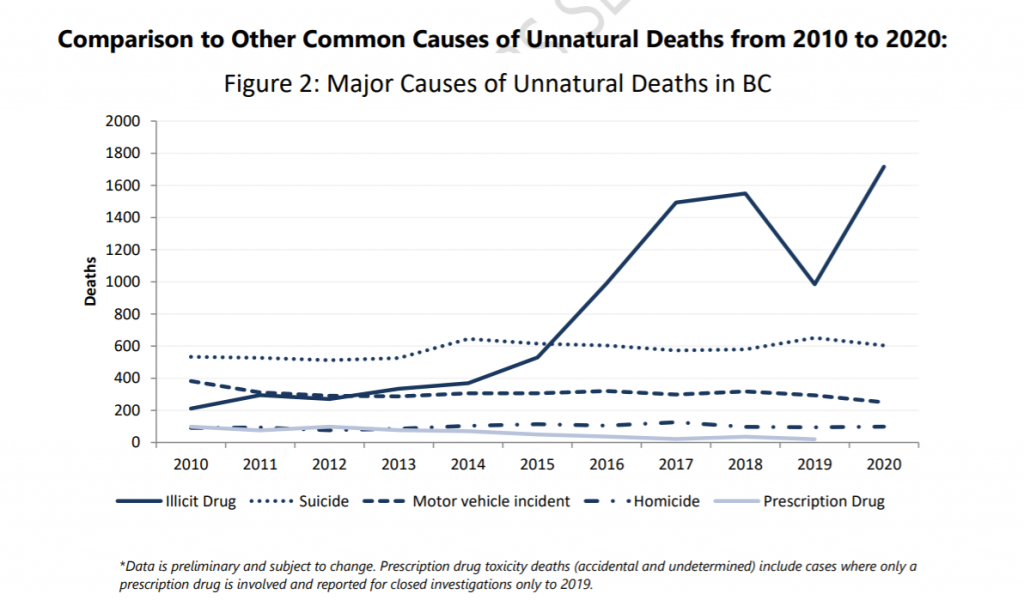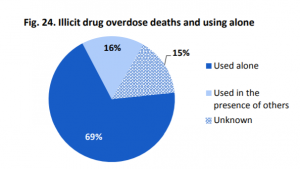Back in the 2018/2019 academic year, I worked on campus as part of a student organization called the First Aid Student Team (FAST). More specifically I was a part of the Education and Outreach Team. While our primary job was to perform first aid at campus events, including parties and community events, we also did a significant amount of education work.
One of the workshops I had the opportunity to run was about safe substance use and the S.A.V.E.M.E intervention protocol. This was one of my first exposures to the devastating impact that the opioid crisis has had on the Vancouver community. Between 2015 and 2016, unintentional overdose deaths increased 87%, then increasing by another 51% the following year. These massive spikes are almost entirely due to fentanyl being present in 85% of overdose deaths. 
Fortunately, in 2019 we saw a substantial 36% decrease in unintentional overdose deaths in BC. While there isn’t any concrete information behind this drop, experts in the field believe it to be due to the increased prevalence of naloxone alongside behavioural changes of substance users. Despite this encouraging drop, it was entirely undone by 2020.

Between January and June 2018, 69% of overdose deaths occurred while using alone, and 85% of overdose deaths have no associated 911 call. Both of these key factors relating to the prevalence of opioid related deaths are accentuated by the isolating nature of COVID-19 lockdowns.
So long as the Canadian government doesn’t follow Portugal’s example of mass legalization, there really isn’t any way to completely eliminate fentanyl related overdoses. However, a crucial measure that can be easily taken is opening more supervised consumption sites. Over the last decade, there has not been a single death in British Columbia at these sites. The bottom line is, safe consumption sites save lives and that is the essential for promoting community safety and wellbeing.
KateAbram
March 2, 2021 — 5:36 pm
Hi Bryce,
Thank you for this informative blog post. The Opioid Crisis in Canada and British Columbia is truly devastating. Unfortunately, the effects of COVID-19 that you’ve discussed in this blog post represent two of the cruelest realities of the pandemic: death and the disproportionately devastating effects of COVID-19 on marginalized and vulnerable communities. A note of hope in your blog post, however, is the decrease in fatal overdoses that could be attributed to the widespread availability of naloxone.
One of the most impactful things that I think that we can do as a society to help combat overdose deaths is change how we perceive and react to drugs and drug-users. You’ve highlighted that the Canadian government won’t legalize dangerous substances, and so that puts the onus on society, I think, to be accessible to people who are in crisis who we have the ability to help.
It’s so great that you have experience working with FAST and that you’ve channeled your ability to help others and make an impact!
– Kate
ElsaDoxtdatorJansson
March 31, 2021 — 2:09 pm
What an important topic to discuss! I actually have some personal connection to this topic as one of my friends’ family members passed due to an opioid overdose during covid. From my understanding due to boarders being closed and a lack of drug trafficking across borders, lots of drugs have been laced with fentanyl to increase the weight, which increases the price. I’ve also heard that Seattle is facing a similar issue surrounding a drug crisis. I wonder when borders do reopen if the numbers of overdose would lower? And what systems can be put in place to lower the number in the meantime?
kenan taraklioglu
April 12, 2021 — 8:27 am
Hey Bryce,
Thanks for the great blog post! The opioid overdose crisis in Canada and specfically in BC is really concerning. In my first year, I remember that you were able to find naloxone in every student residence. As you said, without mass legalization, it is not possible to see a decrease in number of overdoses. It is not easy for an individual to understand whether a drug have been laced with fentanyl or not. Hopefully, after mass legalization, all drug users will be able to find safe version of those drugs and safely consume it at supervised consumption sites. Do you think there are other ways to combat the opioid crisis?
-Kenan
BryceNiebuhr
April 12, 2021 — 5:56 pm
Thank you for commenting Kenan! I by no means claim to be an expert in the area of overdose prevention, but with the work experience that I have I would consider community de-stigmatization as an excellent goal to work towards. The majority of overdoses happen alone, and this problem has only been exaggerated because of the pandemic. Drug use is an addiction, and ostracism from communities often times only pushes victims of addiction further into their vice. This is a solution that isn’t as simple as passing legislation, but societal behavioural change can only help. Acceptance is the first step to healing, so that seems like an excellent place to start.